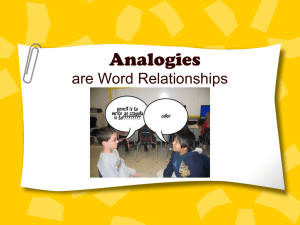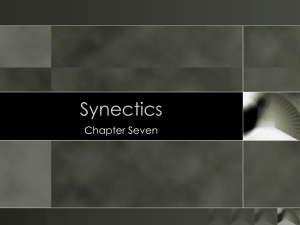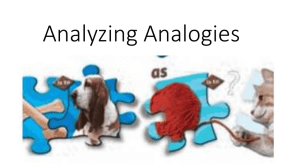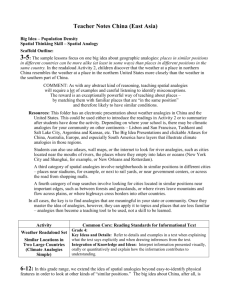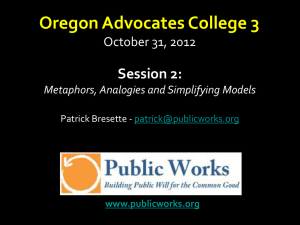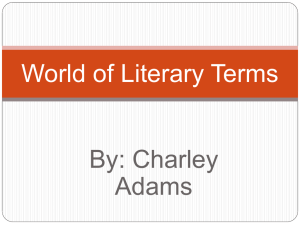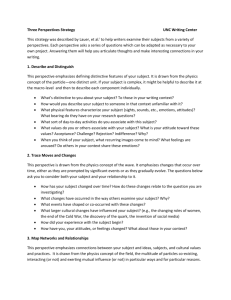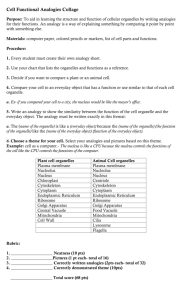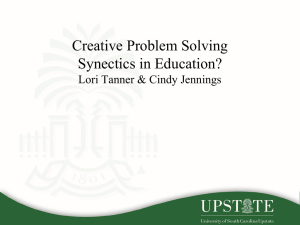Students` reasoning in making predictions about novel situations
advertisement
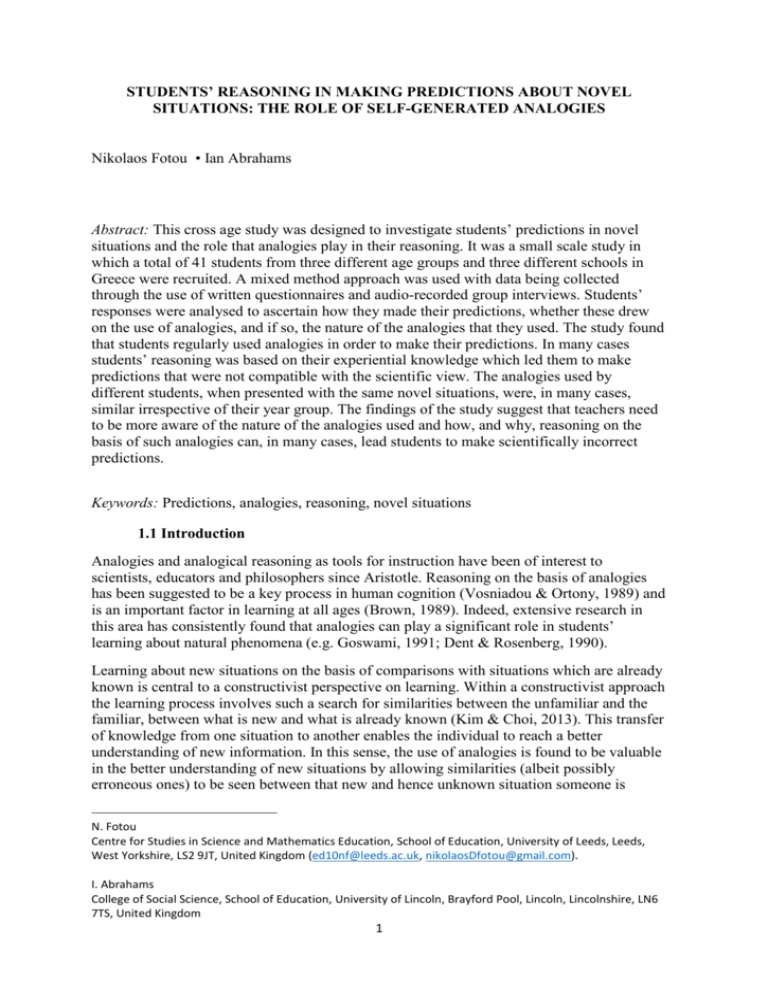
STUDENTS’ REASONING IN MAKING PREDICTIONS ABOUT NOVEL SITUATIONS: THE ROLE OF SELF-GENERATED ANALOGIES Nikolaos Fotou1 • Ian Abrahams2 Abstract: This cross age study was designed to investigate students’ predictions in novel situations and the role that analogies play in their reasoning. It was a small scale study in which a total of 41 students from three different age groups and three different schools in Greece were recruited. A mixed method approach was used with data being collected through the use of written questionnaires and audio-recorded group interviews. Students’ responses were analysed to ascertain how they made their predictions, whether these drew on the use of analogies, and if so, the nature of the analogies that they used. The study found that students regularly used analogies in order to make their predictions. In many cases students’ reasoning was based on their experiential knowledge which led them to make predictions that were not compatible with the scientific view. The analogies used by different students, when presented with the same novel situations, were, in many cases, similar irrespective of their year group. The findings of the study suggest that teachers need to be more aware of the nature of the analogies used and how, and why, reasoning on the basis of such analogies can, in many cases, lead students to make scientifically incorrect predictions. Keywords: Predictions, analogies, reasoning, novel situations 1.1 Introduction Analogies and analogical reasoning as tools for instruction have been of interest to scientists, educators and philosophers since Aristotle. Reasoning on the basis of analogies has been suggested to be a key process in human cognition (Vosniadou & Ortony, 1989) and is an important factor in learning at all ages (Brown, 1989). Indeed, extensive research in this area has consistently found that analogies can play a significant role in students’ learning about natural phenomena (e.g. Goswami, 1991; Dent & Rosenberg, 1990). Learning about new situations on the basis of comparisons with situations which are already known is central to a constructivist perspective on learning. Within a constructivist approach the learning process involves such a search for similarities between the unfamiliar and the familiar, between what is new and what is already known (Kim & Choi, 2013). This transfer of knowledge from one situation to another enables the individual to reach a better understanding of new information. In this sense, the use of analogies is found to be valuable in the better understanding of new situations by allowing similarities (albeit possibly erroneous ones) to be seen between that new and hence unknown situation someone is N. Fotou Centre for Studies in Science and Mathematics Education, School of Education, University of Leeds, Leeds, West Yorkshire, LS2 9JT, United Kingdom (ed10nf@leeds.ac.uk, nikolaosDfotou@gmail.com). I. Abrahams College of Social Science, School of Education, University of Lincoln, Brayford Pool, Lincoln, Lincolnshire, LN6 7TS, United Kingdom 1 presented with and a more familiar situation. More recent research (Jeppsson, Haglund, Amin & Strömdahl, 2013) has shown that analogies could be productively used in novices’ learning as a resource towards expertise. However, the introduction of analogies as a more effective way of teaching is not a panacea with Duit, Roth, Komorek and Wilbers (2001) describing such a use of analogies as passing between Scylla and Charybdis. Niebert, Marsch and Treagust (2012) analysing studies dealing with the use of analogies as instructional tools showed that they are often not understood as intended, or not used by students in their own explanations, and that this could be because these analogies do not fit with students’ experiences and knowledge. Studies in the area of students’ use of analogies have focused more on how analogies provided to the students by teachers and/or researchers can be used effectively inside classroom as a tool for learning new concepts (e.g., Venville & Treagust, 1996; Summers, Kruger & Mant, 1997). Few studies, have examined the spontaneous generation of analogies by students themselves (but see Sandifer, 2003) and whether these self-generated analogies can be used by them in an attempt to better understand a situation they have not considered before. As such, whilst prior research has added instructional value to the use of analogies, details are still missing as to whether there is any connection between the analogies generated and misunderstanding of new situations. Moreover, as several authors have argued (e.g., Wong, 1993; Pittman, 1999) self-generated analogies might serve as a diagnostic form of assessment thus revealing any ideas that might be held by students and which might be inconsistent with the scientific point of view. In other words, self-generated analogies could also be used as a potential approach for the identification of students’ prior knowledge and incorrect ideas. Questions therefore remain as to the source of knowledge students draw upon when generating analogies and the extent to which particular analogies could be an important factor in finding out whether, how and why these analogies could make students misunderstand new situations and come to incorrect conclusions. What has not yet been investigated is the extent to which students’ use of analogies could be useful in a better understanding of how and why students made either correct or incorrect prediction in novel situations. In this sense, asking students to generate their own analogies for new situations and phenomena could be a useful tool for the identification of challenges to learning and understanding. These self-generated analogies could reveal what is familiar to the students and this could help teachers to generate analogies that fit to the formers’ experience and knowledge. This would make analogies more functional in the learning process resolving the aforementioned discontinuity of the use of analogies between students and those who generate and provide them to the latter (Niebert et al., 2012). This paper presents the findings from such a study which was designed in such a way so as to present students with questions about novel situations that it was highly unlikely they would have encountered before. These questions were presented in a pictorial form and students had to answer about the outcome of a future event. In other words, students were asked to make a prediction about what eventually happen in the situation they were presented with. What was examined was whether students of different age self-generate analogies while they use their prior knowledge in making their predictions, the ideas they expressed in order to explain what led them to make their predictions as well as the compatibility of their predictions with the scientific perspective. Accordingly, this study was guided by the following research question: a) What predictions do students of different ages make regarding novel situations? 2 b) Do students of different ages draw on analogies when making predictions and if so, on what analogies do they draw? 1.2 Theoretical framework 1.2.1 Analogy In terms of the structure of analogies, we assume in this study that it is similar to that of examples, models or metaphors, albeit there are some differences and several authors have different concepts in mind when the employ these terms (Duit, 1991). Others, however, have argued that all of these different terms coexist with analogy, they are close relatives and moreover they are sometimes used interchangeably (see, for example, Thomas, 2006). Generally speaking, analogies have two main components -the base and the target. The latter is the novel situation which is under consideration whereas the former refers to the known situation which will form the basis to approach the target (Gentner, 1989). These two components share different kinds of similarities which can be used in order to approach the novel situation on the basis of the familiar. Among such similarities, some are related to characteristics and features of the compared entities (surface similarities), while others were associated with relational and structural information (structural similarities) concerning such entities. In this sense, surface similarities refers to mapping attributes or descriptive properties of objects like shape, size and colour whereas structural similarities concerns the matching of processes and functions between the elements that are considered to be similar. An example of mapping surface similarities could be the comparison of a shoe with a tire founded upon the fact that both are made of rubber which is usually black, whereas an example of mapping structural similarities could be the solar system as an analogy for the planetary model of the atomic structure (similarities in orbits between electrons around the nucleus and planets around the Sun). We consider analogical reasoning to be that process of using analogies to compare structures between two domains and map relations from a familiar (base) situation to a novel (target) situation (Figure 1.2). Figure 1.2 Basic elements involved in analogical reasoning. 1.2.2 Spontaneous analogy Following Clement (1987) the term ‘spontaneously generated’ analogy is used in this study to mean self-initiated analogy in contrast to those analogies presented by the teacher to the student in order for them to complete or use it to explain and/or understand a phenomenon or a concept. In this sense, a spontaneous analogy is similar to a self-generated analogy which whilst also generated by the student differs from a spontaneous analogy in that whilst a self-generated analogy could be prompted, a spontaneous analogy should be self-initiated. Clement (1988) identified three methods for generating such analogies and these methods share many features in common with those made by Gentner (1983). These three methods are: 3 a) Generation on the basis of a formal principle. In this case a student generates an analogous situation by recognising the target as an example of a formal abstract principle (for example, conservation of charge or energy) or single equation. The base is then generated as a second example of that principle or equation. b) Generation based upon a transformation. In this situation very few elements of the target are modified in order for the analogous situation to be generated. In this method the student makes no mention to a formal abstract principle or equation. c) Generation through an association. In this case the student is reminded of an analogous situation which may differ in many aspects from the original situation but they still perceive many features between that analogous case and the target. 1.3 Research Methodology 1.3.1 Study sample The sample of this cross age study was composed of students from, three schools, each of the three main levels within the Greek education system and with each year group recruited just from one school. Being a small scale study, the sample was composed of 13, 16 and 12 students from Year 4 (primary education), Year 9 (secondary education, Greek ‘Gymnasium’) and Year 11 (secondary education, Greek ‘Lyceum’) aged 9-10, 15-16 and 16-17 years respectively. The process for selecting the schools was principally concerned with ensuring what Ball (1984) refers to as “naturalistic coverage” (p. 75) rather than with meeting the statistical sampling requirements associated with traditional quantitative research. Therefore the schools were selected opportunistically so as to ensure a sample that was, in terms of size, status, and socio-economic background, broadly representative of schools across the same geographical region of central Greece. Given the ethical obligation to protect the anonymity of the participants (FrankfortNachmias & Nachmias, 1992) a system of codes was used rather than real names. Codes started with S (to indicate student) and it was followed by a number indicating the Year of the student followed by another number identifying a unique student within the whole study (Student 1, 2, 3 etc...). So, for example, S4.5 would indicate that this student is in Year 4 and that they are recorded as student number five in this study. 1.3.2 The research instrument The situations presented to the students about which they were asked to make a prediction were novel in the sense that they had not been asked previously to think and make predictions about them. As such students’ predictions, regarding those specific situations, were considered to be new in the sense that it was very unlikely that the students would have had any prior opportunity to have thought about those specific situations before they were presented to them in this study and thus could not have pre-existing answers for these questions. With images playing an important role both in memory (Marks, 1973) and the enhancement of students’ recall of information (Purkel & Bornstein, 1980), it was decided to present the questions in a pictorial form. As Banikowski and Mehring (1999) argued, the use of pictures allows prior knowledge of a situation held by students to influence their understanding of something new - like the novel situations students were presented with. This approach also had the advantage that pictures have the potential to be very effective in terms of generating engagement (Kaplan & Howes, 2004; Miles, Kaplan & Howes, 2007) a fact that was considered important in work across such a wide age range and also that combining these 4 with the use of written multiple choice questions has the potential to reduce ambiguity (Bock & Milz, 1977). Pictures were also used to avoid providing any kind of lead to the students in terms of selecting one particular option from those listed in the accompanying multiple choice question. Examples of these pictorial questions can be seen below (Figure 1.3.1, 1.3.2 and 1.3.3). Each novel situation and associated multiple choice question were followed by an openended question in which students were asked to explain what led them to make their prediction (‘What makes you think that?’). Figure 1.3.1 Weight and gravity novel as presented to the students Figure 1.3.2 Burning a candle novel situation as presented to the students Figure 1.3.3 Burning iron wool novel situation as presented to the students 5 1.3.3 Procedure The data collection session involved two phases and lasted approximately two hours for every age group. Being a mixed method study a series of semi-structured group interviews/discussions were carried out in combination with the administration of a paperand-pencil survey. In the first hour, the questionnaire was administered to the students who were asked to complete it without any guidance being provided. In the questionnaire students were asked to make predictions about certain novel situations (closed-choice question) and then to provide explanations about those predictions (open-ended question). Straight after the students completed the questionnaire they were divided into two groups of about five participants for each age group and they were interviewed for one hour. The interviews were conducted directly after the questionnaire was completed in order to prevent them having time to develop second thoughts about the predictions they had made and/or discuss the novel situation with their classmates as doing such might risk losing the spontaneity of their earlier predictions and the explanations as to their reasons for using them that were to be probed in these interviews. Semi-structured group interviews, considered an effective means of generating a considerable amount of relevant information within short periods of time (Webb & Vulliamy, 1996), were used to explore the students’ analogical reasoning. The interviews adopted a clinical interview approach (Clement, 2000) in which students sat around tables and the researcher asked them about the prediction they made in the novel situations and to explain what led them to make their particular choice in responding to a question on a novel situation in the earlier questionnaire. Instead of simply asking the question ‘what makes you think that?’ as had been the case with the open-ended question in the questionnaire, there were additional questions, during the group interviews that were used to help scaffold students’ explanations of their thinking and prompt reference to analogies in their answers. Although these questions were not standardized some basic questions such as, ‘why do you think this will happen?’, ‘what makes you think that?' or ‘why do you think your prediction is the correct one?’ were used. 1.3.4 Data analysis The data collected through the questionnaire were quantitatively and qualitatively analysed with the students’ predictions, made in the first part of questionnaire, being statistically compared across the three different age groups. Written responses in the open ended questions of the questionnaire were examined to see whether there was evidence for the use of spontaneous or self-generated analogies in the explanations students provided in order to explain what led them to make their prediction. The group audio-recorded discussions were transcribed and subsequently analysed to ascertain the method of analogy generation used, as well as the basic idea upon which students claimed that they made their prediction. The identified analogies in students’ explanations from the interview transcripts, as well as their written responses in the questionnaire, were analysed in terms of Clement’s (1988) framework. It should be noted here that Clement’s thee methods for generating analogies derived from experts’ thinking of novel problems3. 3 By using this framework we make no claim of similarities or comparisons, between students’ reasoning and that of experts in Clements’ study because students do not have the same categorization and reasoning ability that scientists have (Chi, Feltovich, & Glaser, 1981). In this sense, the framework was only used to classify the way that analogies were generated (the use becomes clearer in students’ analogies presented in the results section). 6 Moreover, explanations that involved analogies being generated without any elicitation were classified as ‘direct spontaneous explanations’ (DSE). Such DSEs were unexpected in the interview transcriptions because it was felt that if students were about to reason spontaneously, on the basis of analogies, when explaining their prior prediction (their choice in the closed-choice question) this way, they would have done so when they were completing the questionnaire and thus, this type of explanations (DSE) would be identified in students’ responses written on the space the questionnaire included to provide an explanation to the open-ended question. Analogies that were generated spontaneously by students when they were asked to elaborate more on their explanation constitute another category and are referred to as ‘indirect spontaneous explanations’ (ISE). The third and final category, ‘prompted indirect explanations’ (PIE), is when students were asked to provide an analogous case with the one already presented to them. In contrast to the spontaneously generated analogies ISEs and PIEs were used essentially to code students’ explanations identified in the interview transcripts. Students’ responses in the open ended question of the questionnaire and responses recorded in the interview settings were combined in order to identify common themes. The predictions made, as well as the analogy generation method and the analogies themselves, were compared among the three different groups. Two science education researchers and one more person (outside the area of science education specialism) analysed the data (questionnaire and interview responses) and coded the responses. Where disagreement about the coding existed it was resolved through discussion among the coders. 1.4 Results There were many similarities among students’ predictions with the majority of students choosing the same option in the multiple choice question. From the 41 students in this study, 34 made the predictions that might have been expected based on the existing literature on students’ ideas about phenomena that were is some ways similar to those presented in the novel situations. Across the six novel situations only 38 out of the 246 (15%) of the predictions were correct although students in Years 4 and 9 made fewer scientifically correct predictions compared to students in Year 11. Many of the students (39 out of the 41 students) looked for analogous cases that would help them in formulating (or selecting) the correct answer in the multiple choice question relating to a novel situation. The analogies students generated were drawn from phenomena that they had, generally speaking, observed in their early childhood. This became apparent as some of the older students made use of the same analogies as those used by the younger students although the frequency with which they drew on those analogies was much lower than that for the two younger student groups. Although it might be argued that in some cases the analogous situations identified (see, for example, the response provided by S9.1 below) could be considered more akin to examples we argue that these could also be seen as analogies in the sense that the novel situations, in which students attempted to make a prediction and explain what led them to the latter, were analogous to their stored experiential knowledge. For these predictions a total of 234 analogy explanations were generated of which 108 were DSE, 103 were ISE and 23 were prompted by the researcher. It emerged that students across the three different age groups, used similar, and in many cases identical, analogies in order to make their predictions. Also, even if the analogies generated were not identical they were similar in terms of the elements that students focused on and changed in order to generate 7 the analogies as described above. The following two responses given for the novel situations two and five as shown in figures 1.3.1 and 1.3.3 illustrate this point: In my opinion bulb A will switch on first because the left box has greater mass than the right and therefore, the one that includes greater mass will fall down first. I think that this is like the example in which we throw from the top of a roof a dumbbell and a feather, the dumbbell always falls faster. This happens because the weight is greater. (S9.1) I have replied that bulb A switches on. This is because when burning, there is a decrease in the mass of the wire sponge. Isn’t this like having two matches on a beam? If we set one of them on fire, it gets burnt losing its weight and thus making the beam lean to the other side. (S4.3) It can be seen in the first example that the student, as was the case for many others students across the three age groups, changed very few characteristics of the novel situation (the target) generating in this way an analogous situation (the base) that, according to the answer given, helped in making a prediction. They focused on the difference of mass between the animals being placed in the boxes (the elephant and ant) and their analogy was generated by simply exchanging these two animals with two others with which they had more direct personal experiences4. From the 41 students in this study 26 followed a very similar reasoning process in this novel situation. The only difference being that instead of replacing the elephant and the ant with a dumbbell and a feather respectively students provided analogous cases of two other objects being dropped from the same height (for example, a brick and a piece of paper, an olive and an olive leaf) or they even gave examples of two people of different mass (a fat and a thin one as some students wrote) falling from a tree, a roof or into the sea. This way they came to the same conclusion making an erroneous prediction according to which the box with the elephant falls faster (bulb A is switched on first). However, in this situation the scientific prediction is that both bulbs light at the same time because their acceleration under gravity is constant for both masses (ignoring air resistance). The response given by S4.3 is similar in that the analogy was generated by simply exchanging the less familiar object of iron wool being burnt with lit matches that they were more familiar with. In agreement with Wellman and Gelman (1998), students in the present study appeared to be paying attention both to surface and structural similarities. However, cases in which students tried to compare only surface similarities failed to generate analogies that would be helpful in facilitating their understanding of the novel situations. For example, in the weight and gravity situation there were four cases in which younger students (aged 9-10 years) focused on the type of animals and their size. These students made the prediction that the box with the elephant reach the ground first and during the group discussions they generated the analogy that an elephant is like a cow (or other big heavy animals) and the ant is similar to a bee in order to think about, and deal with this novel situation. Although they were able to 4 Students are certainly familiar with elephants and ants but we argue here that they might have little personal experience of handling them as they might have with dumbbells and feathers which are objects that also have very different masses as well. 8 identify size and weight within both the base and target objects as being common attributes, their analogy was limited to the mapping of these surface similarities and albeit they were questioned further they could not see and they did not refer to any relational similarities concerning the existence (if any) of a relationship between the mass and the speed of their two animals falling to the ground (e.g. that the cow goes faster than the bee). It is not clear therefore whether it was the mapping of these surface similarities that advanced their thinking and reasoning about this situation and thus it cannot be argued that it was the analogies themselves that led them to their predictions. On the other hand, within the same novel situation, there were cases in which surface similarities acted as a starting point from which students went on to discover further similarities, like the connection of greater mass with faster motion. This is how they came up with an analogy which helped them to make their predictions. There were also cases in which the focus on structural similarities appeared to play an important role in guiding the generation of analogies. For example, in the situation involving a burning candle (Figure 1.3.2) a 10-year-old student wrote: Bulb A will be switched. Mass decreases as the candle burns and thus the beam turns to the side of bulb A. It is like having a wet sponge and a dry one trying to balance them on a beam. The only way to make it is to squeeze and twist the wet one. (S4.2) There are no obvious surface similarities between a lit candle and a wet sponge and it appears that, in this example, all information was functional. However, these similarities contributed to what Mozzer and Justi (2012) refers as “the initial access stage” (p. 434) of the analogy generation. The generation of analogy was facilitated by this student’s experiential knowledge about something flowing from these two objects and this is how the analogy was generated. These findings challenge the claim made by Gentner (1989) according to which young students rely merely on object attributes, or surface similarities, when they attempt to reach solutions on the basis of analogies. Rather it appears that in the current study students across the three age groups focused on both surface and functional similarities. Having as a starting point the descriptive properties, which are easily accessible (Vosniadou, 1989, Haglund, Jeppsson & Andersson, 2012), students mapped the explanatory structure that both the base and target shared and then subsequently spontaneously generated the analogies and used these as a basis for making their predictions. As Brown (1989) and Ross (1989) have argued, paying attention to surface similarities can lead to the discovery of similarities in the underlying structure of these objects or, as Vosniadou (1989) argues, surface similarities of objects can lead to “deeper, less easily accessible properties in a complex causal/relational network” (p. 418). This is the mechanism that seems to better describe how students in the present study generated the analogies. There are several studies which support this idea (e.g., Vosniadou, 1989, Dunbar & Blanchette, 2001). Most of the analogies identified were generated via a transformation. Only very few elements were changed in order for an analogy to be generated. Most of the students selected as base entities situations that had similar features to the entities of the novel situation (the target) they were trying to explain. The generation method of transformation was evenly distributed among the three age groups in the six novel situations and was the most common method for generating analogies among this study sample. 9 From the total number of 234 analogies identified, 41 were coded as being generated via an association. The analogy generated by S4.2 is a typical example of this generation method. As it can be seen in the example above, this student, focused on the element of the liquid that flows while the candle is burning and this focus led the student to make a prediction that there is a loss of mass as it reminded them of an analogous situation that was different in many ways from the burning a candle situation. Whilst their reasoning is incorrect in the sense that although the candle loses mass this is not due to the wax drops that flow (these were, in the diagram, retained on the pan balance with the rest of the un-burnt candle) but it is due to the carbon particles in the candle reacting with the oxygen in the air to make carbon oxides. Subsequently, this gas (COx) is given off and therefore the remaining candle weighs less than before being lit. Nevertheless, there were students who made the correct prediction in this question by reasoning on analogies and furthermore, in explaining their answers did use scientifically compatible ideas. This is shown in the questionnaire script response below: I chose A bulb to light up. I can see that this is like the case of a piece of paper. After being burnt, the paper will not have the same weight anymore, it becomes lighter. I think that the same happens with the candle, it loses its weight as it gets burnt. (S11.3) In the above response this student, as was the case for many others (28 out of the 41 students followed a similar reasoning process), focused on the element of an object being burnt in order to come to the conclusion that burning objects lose their weight or to justify what makes them believe that the latter is a correct idea which indeed appears to be compatible with the scientific view in this novel situation. In other words, there might be some cases in which students’ ideas of objects being burnt are not only incorrect, in relation to the experiences they are based upon, and yet, as the above example shows, they can be used to make correct predictions in the case of novel situations. Nevertheless, students who came to a correct prediction in the novel situation 1 (Figure 1.3.2), made an incorrect prediction about novel situation 5 (Figure 1.3.3) by following a very similar reasoning process and using similar analogies. In both cases, the most common underlying idea identified in students’ responses is that there should be a decrease in the mass of objects being burnt. Students’ explanations offered about their ideas and what led them to make their prediction explained what led them to think that burning objects lose weight. It appeared that their idea is a reflection upon experiences like firewood being burnt and the remaining ash - which is less bulky than the wood and the coal - being lighter (this analogy was the one most frequently expressed about these two novel situations). Whilst this is correct for the burning candle situation, and can lead to a correct prediction, this is not the case for the iron wool. In contrast to the first case in the iron wool situation the iron wool has chemically combined with oxygen during the burning process and thus, having oxidized to form an ‘ash’ of iron oxide, its weight would increase. One possible explanation concerning what led students to a correct prediction in the first case is that they made their prediction on the basis of their experiential knowledge of burning fuels which, in general, will be materials that, whether they know this or not, contain carbon. On the other hand there appears to be an absence in students’ everyday experiences of objects known to contain iron being burnt. As such, they were led to an incorrect prediction in the iron wool situation because they draw on analogous cases of carbon made materials being burnt. This suggests that there could be some cases in which 10 students have done their observations well and they can use this experiential knowledge in such a way as to help them to understand new phenomena and information. 1.5 Discussion The use of the same analogies by students across the three age groups suggests that students were, in many cases, led into making incorrect predictions because of their use of analogies drawn from personal and everyday experiences. However, the results also suggest that spontaneously generated analogies, although frequently leading to erroneous predictions, do have the potential, in some situations, to lead to scientifically compatible predictions. Nevertheless, how this is possible and under which circumstances it occurs are questions still remaining open for investigation. We are continuing with further research upon this issue. The spontaneously self-generated analogies showed that students were forced to look for similarities between the novel situation (target) and their prior experiential knowledge (base situations that they perceived as being similar) and it was in drawing on these that they made their predictions. This supports constructivists’ argument that in order for students to understand a new situation they should construct personal interpretation of new information by using prior experiences (Driver & Bell, 1986). 1.6 Implications These findings suggest some implications for science teaching in that teachers not only need to be aware of students’ prior knowledge (Hewson & Hewson, 1983) but also need to better understand how their students use that prior, often experientially grounded everyday knowledge, when presented with novel situations. In this respect a better understanding of the generation and use of self-generated analogies could be a valuable tool in assisting teachers to address existing students’ ideas which are not compatible with scientific concepts. Conversely, with self-generated analogies reflecting and explaining where students’ erroneous ideas stem from, they could be used in order to help teachers in the identification of the latter. As Huxley (1894) wrote about science education, “all truth, in the long run, is only common sense clarified” (p.282). Therefore, it is important for students to be given the opportunity to connect reasoning in science with their common sense which, as the study showed, is actually how many of them reason in their everyday life. What should be noted here is that the findings of this study are based on a relatively small localized study from one geographical area in Greece and, as yet, we make no claims about their generalisability. We are continuing with further research to explore students’ predictions and explanations in these novel situations with a larger study sample that will also include individual, as opposed to small group interviews with all students in order to gain deeper insights about their predictions and reasoning in novel situations. Future research could also focus on students’ reasoning in a larger range of novel situations and across different countries in order to see if reasoning spontaneously in novel situation, using analogies, is a common way of understanding new situations. Acknowledgements The authors would like to thank all the students who took part in this study as well as their parents, teachers and head-teachers. 11 References: Ball, SJ (1984) Beachside reconsidered: Reflections on a methodological apprenticeship. In: Burgess RG (ed), The research process in educational settings: Ten case studies. The Falmer Press, Lewes. Banikowski AK, Mehring TA (1999) Strategies to enhance memory based on brainresearch. Focus on Exceptional Children 32(2):1-16. Brown A. (1989) Analogical learning and transfer: What develops? In: Vosniadou S, Ortony A (eds) Similarity and Analogical Reasoning. Cambridge university press, New York Chi MT, Feltovich PJ, Glaser R (1981) Categorization and representation of physics problems by experts and novices. Cognitive science 5(2):121-152. Clement JJ (1987) Generation of spontaneous analogies by students solving science problems. In: Topping D, Crowell D, Kobayashi V (eds) Thinking across cultures, Lawrence Erlbaum Associates, Inc. Publishers, Hillsdale. Clement JJ (1988) Observed methods for generating analogies in scientific problem solving. Cognitive Science 12(4):563-586. Clement JJ (2000) Analysis of clinical interviews: Foundations and model viability. In: R. Lesh R, Kelly A (eds.) Handbook of research design in mathematics and science education. Lawrence Erlbaum, Mahwah. Dent C, Rosenberg L (1990) Visual and verbal metaphors: Developmental interactions. Child Development 61(4):983–994. Driver R, Bell B (1986) Students' thinking and the learning of science: A constructivist view. School Science Review 67:443-456 Duit R (1991) On the role of analogies and metaphors in learning science. Science Education 75(6):649–672. Duit R, Roth WM, Komorek M, Wilbers J (2001) Fostering conceptual change by analogiesbetween Scylla and Charybdis. Learning and Instruction 11(4):283-303. Dunbar K, Blanchette I, (2001) The in vivo/in vitro approach to cognition: The case of analogy. Trends in Cognitive Science 5(8):334-339. Frankfort-Nachmias C, Nachmias D (1992) Research methods in the social sciences. Edward Arnold, Sevenoaks. Gentner D (1983) Structure-mapping: A theoretical framework. Cognitive Science 7:155170. Gentner D (1989) The mechanisms of analogical learning. In: Vosniadou S, Ortony A (eds) Similarity and analogical reasoning, Cambridge, New York. Goswami U (1991) Analogical reasoning: What develops? A review of research and theory. Child Development 62(1):1-22. Haglund, J, Jeppsson, F, Andersson J (2012). Young children's analogical reasoning in science domains. Science Education 96(4):725-756. 12 Hewson GN, Hewson WP (1983) Effect of instruction using student prior knowledge and conceptual change strategies on science learning. Journal of Research in Science Teaching 20(8):731-743. Huxley TH (1894) Science and education (Collected essays, Vol. III). Appleton, New York. Jeppsson F, Haglund J, Amin TG, Strömdahl H (2013) Exploring the use of conceptual metaphor in solving problems on entropy. Journal of the Learning Sciences 22(1):70-120. Kaplan I, Howes A (2004) Seeing through different eyes: Exploring the value of participative research using images in schools. Cambridge Journal of Education 34(2):143155. Kim M, Choi K (2003) Access to structural similarity in the analogical problem solving of children. School Psychology International 24(2):218-231. Marks DF (1973) Visual imagery differences in the recall of pictures. British Journal of Psychology 64(1):17-24. Miles S, Kaplan I, Howes A (2007) Using participatory image-based research to inform teaching and learning about inclusion in education. In: Hutchings W, O’Rourke K, Powell NJ (eds) Case studies: CEEBL supported projects, 2005-6, Centre for Excellence in Enquiry Based Learning, Manchester. Mozzer N, Justi, R (2012) Students' pre- and post-teaching analogical reasoning when they draw their analogies, International Journal of Science Education, 34(3): 429-458. Niebert K, Marsch S, Treagust DF (2012) Understanding Needs Embodiment: A TheoryGuided Reanalyses of the Role of Metaphors and Analogies in Understanding Science. Science Education 96(5):849-877. Pittman KM (1999) Student-generated analogies: Another way of knowing? Journal of Research in Science Teaching 36(1):1-22. Purkel W, Bornstein MH (1980) Pictures and imagery both enhance children's shortterm memory and long-term recall. Developmental Psychology 16(1):153-154. Ross BH (1989) Remindings in learning and instruction. In: Vosniadou S, Ortony A (eds) Similarity and analogical reasoning, Cambridge University Press, New York. Sandifer C (2003) Spontaneous student-generated analogies. Proceedings of the 2003 Physics Education Research Conference. Summers M, Kruger C, Mant J (1997) Teaching electricity effectively: A research-based guide for primary science, Association for Science Education. Thomas GP (2006) Metaphor, students’ conceptions of learning and teaching, and metacognition. In: Aubusson PJ, Harrison AG, Ritchie SM (eds) Metaphor and analogy in science education. Springer, Dordrecht, The Netherlands. Venville G, Treagust D (1996) The role of analogies in promoting conceptual change in biology. Instructional Science 24(4):295-320. 13 Vosniadou S (1989) Analogical reasoning and knowledge acquisition: A developmental perspective. In: Vosniadou S, Ortony A (eds) Similarity and analogical reasoning. Cambridge University Press, New York. Vosniadou S, Ortony A (1989) Similarity and analogical reasoning: A synthesis. In: S. Vosniadou S, Ortony A (eds) Similarity and analogical reasoning. Cambridge University Press, New York. Webb R, Vulliamy G (1996) Roles and responsibilities in the primary school: changing demands, changing practices. Open University Press, Buckingham. Wellman H, Gelman S (1998). Knowledge acquisition in foundational domains. In: Kuhn D, Siegler RS (eds) Handbook of child psychology: Cognition, perception, and language, Wiley, New York. Wong E D (1993) Self-generated analogies as a tool for constructing and evaluating explanations of scientific phenomena. Journal of Research in Science Teaching 30(4):367380. 14
